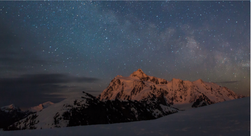Astronomy Binoculars
May 6, 2015
Astronomy Binoculars - Giant binoculars for a giant night sky
Astronomy Binoculars - Viewing the night sky through a pair of binoculars can be a breathtaking experience. Unlike a telescope, a binocular is much more compact and can be quickly taken outside for instant astronomical viewing. When choosing binoculars for astronomy, there are a few choices you need to consider. Will they be handheld or mounted on a tripod? What size and weight binocular are you willing to handle? These decisions will be much easier after reading below. Let's first talk about the basics of binoculars...
Power (magnification) and Objective Lenses - A binocular is measured by its Magnification and its Objective Lens Size. For example, a 10x50 Binocular represents a 10x Magnification with a 50mm Objective Lens. Magnification is represented by an "x" or "times" the naked eye. 10x or 10 times the naked eye. The Objective Lenses are the outside lenses of the binocular and are measured in millimeters.
In astronomy, magnification is not the most important thing! -Viewing the night sky with an instrument, whether it's a binocular or a telescope is not really about magnifying the night sky, but rathergathering light from the object you desire to see. Of course, you are magnifying the distant object your looking at, but its more important to think of it as gathering the light from the distant object and then looking at it closely. The gathering of light comes from the size of theObjective Lens on the binocular. The larger the objective lens, the more light the binocular can gather. The more light the binocular can gather, the better you will see objects.
So you should just pick out the biggest binocular you can find? -Not necessarily. Granted, the larger objective binoculars will gather the most light, but they are also the heaviest and largest of the binoculars. Most large astronomy binoculars above 80mm will be difficult to hold an image steady and will be very front-end heavy due to the large objective lenses. Most extra-large objective binoculars will require a tripod for steady images.
 |
|
The Zhumell Tachyon 25x100 Astronomical Binoculars are a great example of a large sized objective lens binocular. |
Choose by Objective Lens - Not by Magnification
When selecting your astronomy binocular, choose by the objective lens size your willing to use. The magnification levels usually scales with the size of the objective lenses. Some very common sizes forastronomy binoculars are 10x50, 12x60, 15x70, 20x80 and 25x100. There may be some slight changes to these among the many binoculars, but this is a good guide to use. The more objective lens you have, the more light-gathering power your binocular will have, allowing for greater amounts of magnifications.
No Tripod? Use a Lawn-Chair - If your heart is set on a large 80mm or 100mm giant binoculars, and do not want to use a tripod, try a lawn-chair. The classic reclining lawn chairs will let you to lay out under the stars and more importantly allow you to brace the binocular with your elbows and lay back comfortably for more stable viewing. For the most stable possible image, a tripod is preferred.
|
Objective Size |
Magnification |
Tripod Needed? |
|
40mm to 60mm Objective Lenses |
7x-12x |
With or Without Tripod - Easily hand held for astronomy viewing. |
|
70-80mm Objective Lenses |
15x-20x |
With or Without Tripod - Usually best results with tripod - but not unreasonable without. |
|
100-120mm |
25x-40x |
Tripod is almost a must - Very front heavy binoculars |
Our Top Picks for Astronomy Binoculars
|
|
|||
 |
 |
 |
 |
|
Zhumell 20x80 SuperGiant
|
Celestron SkyMaster 15x70
|
Meade 9x63 Astronomical
|
Celestron SkyMaster 25x100
|
|
|
|||
 |
 |
 |
 |
|
Celestron SkyMaster 12x60
|
Celestron SkyMaster 20x80
|
Celestron OptiView 10x50
with Light Polution Filters |
Zhumell Tachyon 25x100
|
|
|
|||
Learning the night sky to locate objects with your Astronomical Binoculars
 |
|
Celestron Sky Maps - Locate objects with your Astronomy Binoculars and learn the night sky. |
Sky Maps - Learn the night sky and locate objects with the use of a Sky Map. The front cover has a specially designed, luminous planisphere that rotates to simulate the seasonal progression of celestial objects through the sky. When the planisphere is pre-exposed to light, star positions glow brightly against a dark background, mimicking actual constellations.
More than a thousand stars and deep-sky objects are listed and charted inside. The illustrated reference section provides basic information and the visual characteristics of various types of stars, nebulae and galaxies.
 |
|
A Green Laser Pointer from Zhumell will point out objects and assist in locating objects in the night sky. |
Astronomical Green Laser Pointer - Once you see one of these in action they are impossible to resist. The pointer is the perfect astronomical accessory for sharing an evening of stargazing with friends. Packed with a full 5mw of power, this green laser will reflect off particles in the air and draw a straight line to the object you've been observing. The beam will carry out to 25,000 feet, or nearly 5 miles, making it easy for friends to find your line of sight - they just look up and follow the beam!
Green laser pointers are the perfect accessory for learning the night sky and locating objects. When you are locating an object with a Sky Map, it's best to move from star to star, known as, "star-hopping" your way to the object. You can use the Green Laser Pointer to point out each of these stars easily and locate your object quickly.



